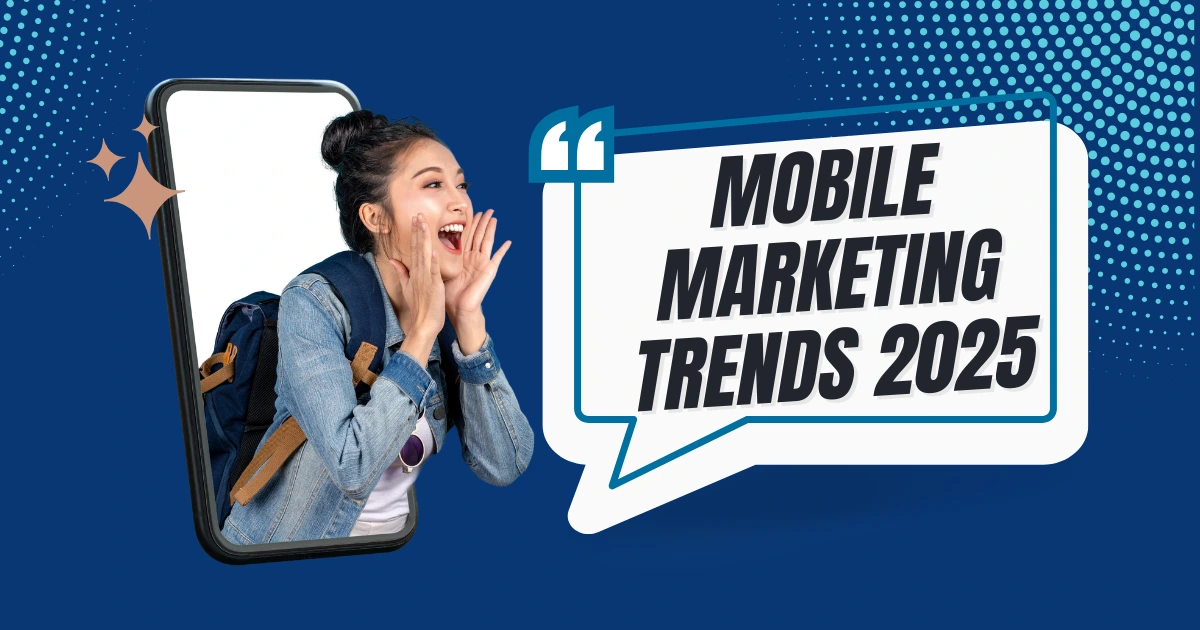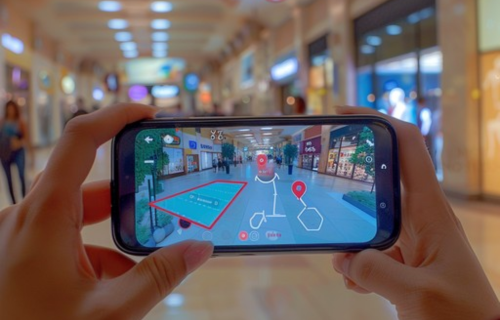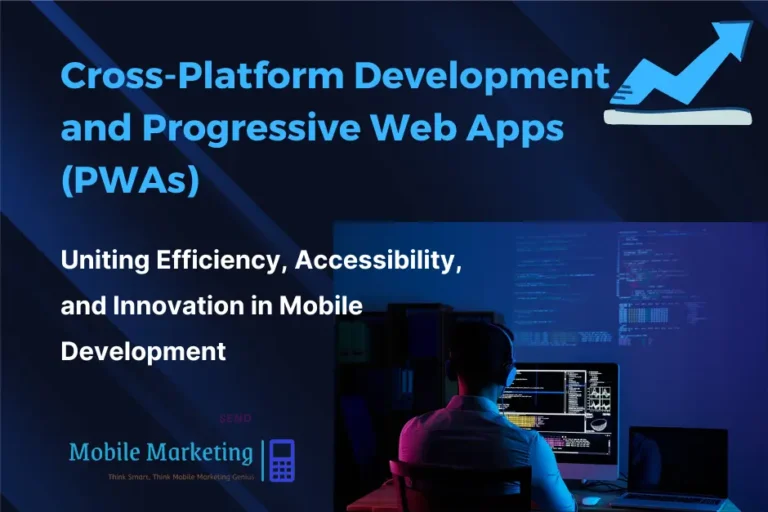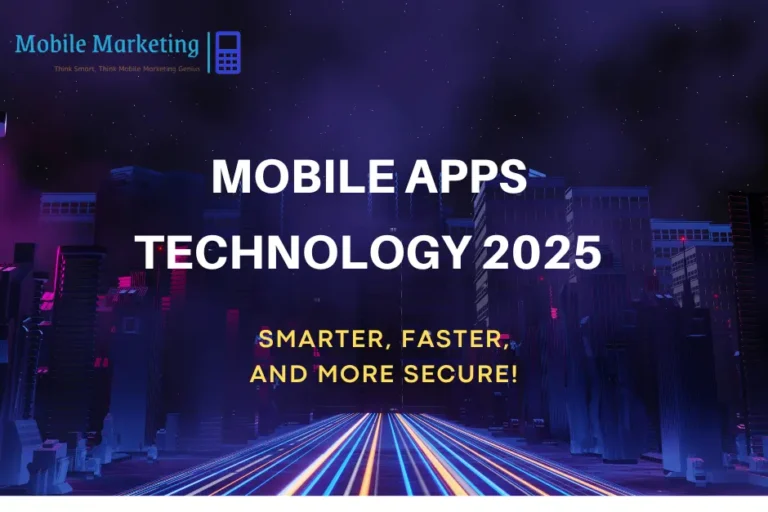Top 10 Emerging Mobile Marketing Trends 2025

The mobile marketing landscape is rapidly evolving, and 2025 promises to bring groundbreaking shifts. As technology advances and user expectations increase, staying ahead of emerging trends becomes crucial for brands to remain competitive and engage their audiences effectively. This article explores ten key mobile marketing trends that will shape the future and offers practical insights for leveraging these developments.
Table of Contents
1. AI-Powered Personalization: Shaping Mobile Marketing Trends in 2025
Definition and Importance
Artificial Intelligence (AI) is revolutionizing the way marketers connect with consumers. In 2025, AI-powered personalization will dominate mobile marketing, allowing brands to deliver highly customized content that speaks directly to individual users’ preferences and behaviors. Imagine a world where your favorite shopping app knows your fashion taste, preferred color schemes, and even the time of day you’re most likely to shop—this level of hyper-personalization is now becoming a reality.
Impact on Marketing
AI-driven personalization enhances the user experience by analyzing vast amounts of data to predict what content or offers will resonate most. By understanding consumer habits, brands can present the right message at the right moment. The result? Increased user engagement, higher conversion rates, and improved customer loyalty.
Real-World Applications
- Dynamic Content: AI will be used to create dynamic content that adjusts in real time based on user interactions. For instance, e-commerce websites will modify their homepage content based on a user’s past browsing behavior.
- Predictive Analytics: Brands will harness AI to forecast consumer trends and optimize marketing campaigns. This can include sending personalized push notifications or email recommendations to users likely to convert.
How to Implement AI-Powered Personalization
- Leverage AI-driven analytics tools: Use platforms like Salesforce, HubSpot, or Adobe Experience Cloud to analyze consumer behavior.
- Utilize machine learning algorithms: Implement machine learning models to automate and tailor marketing messages.
- Invest in data privacy and security: Ensure that your personalization efforts respect user privacy and adhere to data protection laws.
Case Study: Amazon’s Personalization Engine
Amazon’s AI-driven personalization system recommends products based on user activity, significantly boosting sales. In 2025, expect more brands to adopt similar approaches for hyper-personalized marketing.
First-time app installations globally are projected to reach 183.7 billion in 2024.
Table 1: AI-Powered Personalization Technologies in 2025
| Technology | Description | Use Case |
|---|---|---|
| Predictive Analytics | Analyzes user data to predict future behavior | Personalized product recommendations |
| Natural Language Processing (NLP) | Enhances understanding of user queries and content | Chatbots and voice assistants |
| Machine Learning Models | Learns from user interactions to optimize content | Automated content optimization |
| Real-Time Personalization Engines | Delivers tailored content in real time | Personalized mobile app experiences |

2. Voice Search Optimization
The Growing Trend
With the proliferation of voice assistants like Siri, Alexa, and Google Assistant, voice search is becoming a primary method for users to find information. By 2025, optimizing content for voice search will be a necessity as more consumers rely on spoken commands rather than typing.
Strategies for Voice Search Optimization
- Conversational Keywords: Focus on natural language and long-tail keywords that mimic everyday speech. Instead of using phrases like “best pizza NYC,” voice search might involve “Where’s the best pizza place near me?”
- Local SEO: Many voice searches are location-based, so optimizing for local SEO will be critical. Ensure your business is registered on Google My Business and keep your location information up to date.
- Featured Snippets: Structuring content to appear in featured snippets will help improve visibility. Use clear headings and answer common user questions concisely.
Why It Matters
Voice search influences user behavior, especially for on-the-go mobile users who need quick answers. Brands that optimize for voice search will be more accessible and relevant. As smart home devices and car-based voice assistants become more prevalent, the reach of voice search marketing will expand.
Future Outlook
By 2025, over half of smartphone users will use voice commands daily. This shift will necessitate a rethinking of SEO strategies, focusing on conversational content and optimizing for natural language queries.
In the U.S., 41% of adults use voice search daily.

3. Augmented Reality (AR) Marketing
What is AR Marketing?
Augmented Reality (AR) marketing integrates digital elements into the real world, creating interactive and immersive experiences for users. In 2025, AR will be a key strategy for brands looking to engage and captivate their audiences. Picture walking into a furniture store and using your phone to see how a couch would look in your living room—this is AR in action.
Benefits of AR in Mobile Marketing
- Enhanced Engagement: AR experiences are memorable and encourage user interaction. People spend more time engaging with AR content than with traditional media.
- Product Visualization: Consumers can try products virtually before making a purchase, boosting confidence and reducing return rates. For example, beauty brands are using AR to allow users to try on makeup through their smartphones.
Examples and Projections
- Retail: Virtual try-ons for clothing and accessories are becoming the norm, with brands like Warby Parker and IKEA leading the way.
- Real Estate: AR property tours give potential buyers an immersive experience, allowing them to explore properties remotely.
Implementation Tips
- Start small with simple AR features: Test your AR campaigns on a limited scale and expand based on user feedback.
- Collaborate with AR technology providers: Brands can work with companies like Blippar or Zappar to develop custom AR solutions.
- Monitor performance: Use analytics to track how users engage with AR content and optimize for better results.
The global AR market is expected to reach $198 billion by 2025, driven by increased adoption in mobile marketing.

4. 5G-Powered Experiences
The Role of 5G
The rollout of 5G technology will transform mobile marketing by providing faster internet speeds and lower latency. This will enable more seamless, immersive, and high-quality content experiences, revolutionizing how brands interact with consumers on mobile platforms.
Opportunities for Marketers
- HD Streaming: Deliver high-definition videos without buffering. Imagine hosting live events or streaming product demos in real-time with zero interruptions.
- Real-Time Interactions: Enhanced capabilities for real-time gaming and interactive ads. Brands can develop real-time multiplayer games or live quizzes to engage their audience.
- Virtual and Augmented Reality: More complex and engaging AR/VR experiences will become commonplace, thanks to 5G’s increased data capacity.
Impact on User Experience
5G will set new standards for content delivery, making it possible to engage users in ways that were previously unattainable. The faster speeds will also allow for quicker app downloads and smoother browsing experiences.
Best Practices
- Optimize content for 5G networks: Focus on speed and interactivity. Your app or mobile website should load quickly and provide high-quality visuals.
- Experiment with immersive technologies: Use AR and VR to create unique marketing experiences that leverage the power of 5G.
- Stay ahead of trends: Keep an eye on emerging 5G capabilities and adapt your strategy accordingly.
By 2025, 5G networks are expected to cover one-third of the world’s population, enhancing mobile marketing capabilities.
Table 2: Key 5G Mobile Marketing Applications
| Application | Description | Benefits |
|---|---|---|
| HD Streaming | Delivers high-quality, buffer-free video content | Improved user experience |
| Augmented Reality (AR) | Supports high-speed AR experiences | Interactive and engaging marketing |
| Real-Time Gaming | Enables seamless, lag-free mobile gaming | Enhanced gaming experiences |
| Live Event Streaming | Broadcasts events live with minimal latency | Real-time audience engagement |

5. Privacy-First Marketing
Rising Concerns
Data privacy remains a top concern for consumers, and stringent regulations like the GDPR and CCPA are shaping how marketers collect and use data. In 2025, privacy-first marketing will be a must, and brands that fail to prioritize data security will risk losing consumer trust.
Adapting to Privacy Regulations
- Transparency: Be transparent about data collection practices. Let users know what data is being collected and how it will be used.
- Consent Management: Implement robust systems to manage user consent, such as pop-ups asking for permission to use cookies.
- Zero-Party Data: Encourage users to willingly share data through interactive experiences like quizzes, polls, or loyalty programs. Zero-party data is information that consumers intentionally and proactively share with brands.
Balancing Privacy and Personalization
While respecting privacy is crucial, marketers can still personalize content using ethical data collection practices. For example, use anonymized data for trend analysis or segment audiences based on broad demographics rather than personal identifiers.
Case Study: Apple’s Privacy Initiatives
Apple’s App Tracking Transparency (ATT) feature requires apps to get user permission before tracking their data across other companies’ apps and websites. This shift has forced marketers to find creative and privacy-compliant ways to reach their audience.
A survey found that 79% of consumers are concerned about how companies use their data, emphasizing the need for privacy-first marketing strategies.

6. Interactive and Gamified Content
Definition and Growing Relevance
Interactive and gamified content will be vital in keeping audiences engaged. From quizzes and polls to branded games, interactive content can significantly boost user interaction and dwell time. Gamification elements can turn even the most mundane tasks into engaging experiences, like earning points for completing a workout in a fitness app.
Benefits of Gamified Marketing
- Higher Engagement Rates: Gamified content keeps users entertained and invested. It taps into the human desire for competition and rewards.
- Data Collection: Gamification allows for non-intrusive data gathering as users participate in fun, engaging activities.
Examples and Future Trends
- Branded Games: Interactive games that offer rewards or incentives, like Starbucks’ holiday-themed AR games that give out loyalty points.
- AR Quizzes: Using AR to make quizzes more engaging and lifelike. For instance, a beauty brand could create an AR quiz to help users find the perfect skincare routine.
Implementation Tips
- Ensure the content is relevant: Tailor gamified experiences to your target audience’s interests.
- Incorporate reward systems: Offer incentives like discounts, points, or exclusive content to encourage repeat interactions.
- Analyze engagement metrics: Track user behavior to see which gamification elements work best and refine your strategy accordingly.
On average, users spent 4 hours and 6 minutes a day using their mobile phones in 2023.

7. Social Commerce
The Rise of Social Shopping
Social commerce, or shopping directly on social media platforms, is booming. By 2025, this trend will continue to grow, with platforms like Instagram, TikTok, and Pinterest leading the way. Consumers are increasingly using social networks to discover and buy products, creating a new avenue for brands to reach and convert shoppers.
Impact on Mobile Marketing
- Seamless Shopping: In-app purchases make the buying process fast and simple. Users can go from discovering a product to purchasing it without leaving the social platform.
- User-Generated Content: Consumers trust peer recommendations and content more than traditional advertising. Brands can leverage this by encouraging user-generated content that showcases their products in real-life scenarios.
Strategies to Leverage Social Commerce
- Collaborate with influencers: Partner with social media influencers to promote your products. Influencers have loyal followings and can drive significant sales through authentic recommendations.
- Use shoppable posts: Platforms like Instagram allow you to tag products in your posts, making it easy for users to shop directly from your content.
- Invest in live shopping: Live-streamed shopping events are gaining popularity, where brands can showcase products and interact with potential buyers in real-time.
Case Study: TikTok’s Social Commerce Success
TikTok has revolutionized social commerce with features like shoppable ads and the TikTok Shop. Brands are creating viral content that not only entertains but also drives sales. For instance, makeup brands are using TikTok to demonstrate products, leading to immediate purchases.
Social commerce sales in the U.S. are projected to reach $79.64 billion in 2025, accounting for 5.2% of total e-commerce sales.

Table 3: Social Commerce Platforms to Watch in 2025
| Platform | Key Features | Marketing Opportunities |
|---|---|---|
| TikTok Shop | In-app shopping, influencer partnerships | Viral challenges, shoppable ads |
| Instagram Checkout | Direct purchase from posts and stories | User-generated content, sponsored posts |
| Visual search, shoppable pins | Product discovery, brand storytelling | |
| Facebook Shops | Full-featured storefronts on business pages | Personalized shopping experiences |
8. Mobile Wallet and Payment Innovations
Overview of Mobile Payments
The use of mobile wallets like Apple Pay, Google Wallet, and Samsung Pay is surging. In 2025, innovations in mobile payment technology will further simplify and secure transactions. With the rise of e-commerce and in-app purchases, brands must adapt to these changes to ensure a seamless checkout experience.
Consumer Adoption Trends
- QR Code Payments: Widely adopted in Asia, QR code payments are becoming mainstream globally. Businesses are integrating QR codes into physical and digital stores.
- Biometric Authentication: Enhances security and convenience for users. Fingerprint and facial recognition are now standard methods for authorizing transactions.
Marketing Opportunities
- Incentivize users: Offer cashback or discounts for using mobile payments. This can increase adoption and drive repeat purchases.
- Streamline the checkout process: Simplify the payment journey to reduce cart abandonment. Use features like one-click payment options to make transactions as seamless as possible.
Future Outlook
The convenience of mobile payments will encourage brands to offer innovative payment methods and loyalty programs. Expect to see more apps integrating cryptocurrency payments and buy-now-pay-later options.
The number of mobile payment users worldwide is expected to surpass 1.31 billion by 2023, indicating a significant shift towards mobile wallet and payment innovations.
Table 4: Popular Mobile Payment Apps in 2025
| App | Key Features | Security Measures |
|---|---|---|
| Apple Pay | Contactless payments, in-app purchases | Biometric authentication, tokenization |
| Google Wallet | Peer-to-peer payments, NFC-based transactions | Two-step verification, encryption |
| Samsung Pay | Magnetic Secure Transmission (MST) technology | Knox security, fingerprint recognition |
| PayPal | Online shopping, QR code payments | Fraud detection, secure encryption |

9. Enhanced Mobile Video Content
The Power of Video
Video content remains a dominant force in mobile marketing, but in 2025, brands will need to get more creative. From short-form content like TikToks to long-form branded series, video content will continue to evolve. Video consumption on mobile devices has skyrocketed, and consumers expect engaging and high-quality content.
Balancing Short-Form and Long-Form
- Short-Form: Ideal for capturing attention quickly. Platforms like TikTok, Instagram Reels, and YouTube Shorts have popularized this format.
- Long-Form: Provides in-depth storytelling and deeper brand engagement. Documentaries, interviews, and behind-the-scenes content are perfect for this.
Future Trends
- Interactive Videos: Videos that allow users to make choices and influence the storyline. For example, a beauty brand could create an interactive video tutorial that lets viewers choose different makeup looks.
- Shoppable Videos: Making content directly shoppable for a seamless user experience. Viewers can click on products featured in the video to learn more or make a purchase instantly.
Tips for Creating Effective Video Content
- Optimize for mobile viewing: Use engaging visuals and captions to ensure your message gets across even if the sound is off.
- Incorporate storytelling: Connect with your audience emotionally through compelling narratives.
- Use analytics: Track video performance and adjust your strategy based on user engagement metrics.
As of early 2023, 57.08% of internet traffic comes from mobile devices.
Table 5: Emerging Trends in Mobile Video Content
| Trend | Description | Example |
|---|---|---|
| Interactive Videos | Viewers can interact with the video content | Choose-your-own-adventure ads |
| Shoppable Videos | Videos with direct purchase options | Fashion lookbooks, product demos |
| Short-Form Content | Quick, engaging videos for social platforms | TikTok challenges, Instagram Reels |
| Immersive 360-Degree Videos | Full-view videos for a more engaging experience | Virtual travel tours, event coverage |
10. Sustainability and Ethical Marketing
Why It Matters
Consumers are increasingly choosing brands that align with their values, including sustainability and ethical practices. In 2025, ethical marketing will become a key differentiator. Brands that demonstrate a genuine commitment to environmental and social responsibility will stand out.
Brand Responsibility
- Highlight eco-friendly initiatives: Showcase your brand’s efforts to reduce waste, use sustainable materials, or support environmental causes.
- Be authentic and transparent: Consumers are savvy and can spot greenwashing. Be honest about your environmental impact and what you’re doing to improve.
Marketing Strategies
- Use storytelling: Share stories about your brand’s journey toward sustainability. For example, a clothing brand could document how it sources ethical fabrics.
- Partner with eco-conscious influencers: Collaborate with influencers who share your brand’s values and can authentically promote your sustainable practices.
The Consumer Perspective
A Nielsen report found that 73% of global consumers would change their consumption habits to reduce their environmental impact. This trend will only grow, making sustainability a crucial aspect of mobile marketing.
Future Outlook
Sustainability will extend beyond product marketing to include digital practices. For instance, brands will focus on reducing their digital carbon footprint by optimizing websites and apps for energy efficiency.
In 2022, mobile advertising spending reached a record $327 billion worldwide, and according to the latest forecasts, this figure will near $400 billion by 2024.

Conclusion
The future of mobile marketing is brimming with exciting opportunities and challenges, driven by rapid advancements in technology and shifting consumer expectations. By 2025, brands that remain proactive and adaptable will be able to harness these emerging trends to build deeper connections with their audiences. From AI-powered personalization that delivers hyper-relevant content to 5G-powered experiences that redefine speed and interactivity, the landscape is set to become more engaging and user-centric than ever before.
The evolution of voice search and augmented reality will continue to shape how consumers interact with brands, making it crucial for marketers to optimize content and invest in immersive technologies. Additionally, the emphasis on data privacy and ethical marketing will challenge brands to balance personalization with user trust, fostering more transparent and respectful relationships with their audiences.
Mobile marketers must also focus on creating meaningful and interactive content, as gamification and social commerce redefine the buying journey. The rise of mobile payment innovations will further streamline the user experience, ensuring that brands can convert interest into action with ease. Moreover, as video content continues to dominate, the key will be striking the right balance between short-form and long-form storytelling to captivate and inform audiences.
Lastly, sustainability will be more than just a buzzword—it will be a crucial aspect of a brand’s identity. Companies that demonstrate a genuine commitment to environmental and social responsibility will not only appeal to conscious consumers but also set a standard for the industry.
In this fast-evolving world, staying informed and agile is essential. By embracing these trends, brands can future-proof their marketing strategies, drive greater engagement, and achieve long-term success. The mobile marketing revolution is just beginning, and those who innovate and adapt will thrive in this ever-changing digital landscape.







One Comment
Comments are closed.